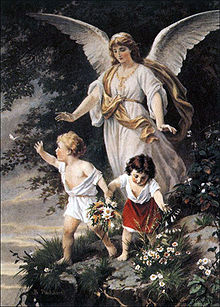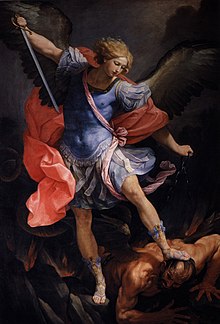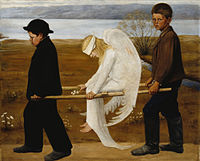
Back Malaikat ACE Engel Afrikaans Engel ALS መልአክ Amharic Engel ANG ملاك Arabic ܡܠܐܟܐ ARC ملاك ARY ملاك ARZ Ánxel AST



An angel is a spiritual (without a physical body), heavenly, or supernatural being, usually humanoid with bird-like wings, often depicted as a messenger or intermediary between God (the transcendent) and humanity (the profane) in various traditions like the Abrahamic religions.[1][2][3] Other roles include protectors and guides for humans, such as guardian angels and servants of God.[4] In Western belief-systems the term is often used to distinguish benevolent from malevolent intermediary beings.[5]
Emphasizing the distance between God and mankind, revelation-based belief-systems require angels to bridge the gap between the earthly and the transcendent realm.[6] Angels play a lesser role in monistic belief-systems, since the gap is non-existent. However, angelic beings might be conceived as aid to achieve a proper relationship with the divine.[7]
Abrahamic religions describe angelic hierarchies, which vary by religion and sect. Some angels have specific names (such as Gabriel or Michael) or titles (such as seraph or archangel). Malevolent angels are often believed to have been expelled from Heaven and called fallen angels. In many such religions, the Devil (or devils) are identified with such angels.

Angels in art are often identified with bird wings,[8] halos,[9] and divine light. They are usually shaped like humans of extraordinary beauty, though this is not always the case—sometimes, they can be portrayed in a frightening, inhuman manner.[10]
- ^ The Free Dictionary: "angel" Archived 8 November 2012 at the Wayback Machine, retrieved 1 September 2012
- ^ "Angels in Christianity". Religion Facts. Archived from the original on 6 April 2015.
- ^ Mircea Eliade Encyclopedia of Religion Macmillan Publishing (1986) p. 282
- ^ Augustine of Hippo's Enarrationes in Psalmos Archived 9 October 2011 at the Wayback Machine, 103, I, 15, augustinus.it (in Latin)
- ^ Mircea Eliade Encyclopedia of Religion Macmillan Publishing (1986) p. 282
- ^ Mircea Eliade Encyclopedia of Religion Macmillan Publishing (1986) p. 284
- ^ Mircea Eliade Encyclopedia of Religion Macmillan Publishing (1986) p. 283
- ^ Proverbio (2007), pp. 90–95; compare review in La Civiltà Cattolica, 3795–3796 (2–16 August 2008), pp. 327–328.
- ^ Didron, Vol 2, pp.68–71.
- ^ Blau, Ludwig; Kohler, Kaufmann. "Angelology". Jewish Encyclopedia. Archived from the original on 20 May 2016. Retrieved 2 May 2016.